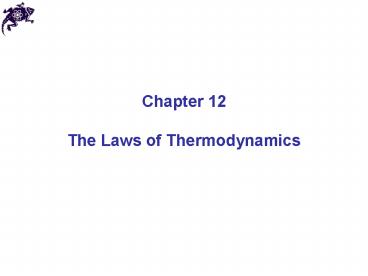The Laws of Thermodynamics - PowerPoint PPT Presentation
Title:
The Laws of Thermodynamics
Description:
Chapter 12 The Laws of Thermodynamics Answers to the even-numbered problems Chapter 12 Problem 36 6.06 kJ/K Answers to the even-numbered problems Chapter 12 Problem ... – PowerPoint PPT presentation
Number of Views:169
Avg rating:3.0/5.0
Title: The Laws of Thermodynamics
1
Chapter 12 The Laws of Thermodynamics
2
Heat and work Thermodynamic cycle
3
- Heat and work
- Work is done by the system
- Work is done on the system
4
- The first law of thermodynamics
- Work and heat are path-dependent quantities
- Quantity Q W ?Eint (change of internal
energy) is path-independent - 1st law of thermodynamics the internal energy
of a system increases if heat is added to the
system or work is done on the system
5
- The first law of thermodynamics
- Adiabatic process no heat transfer between the
system and the environment - Isochoric (constant volume) process
- Free expansion
- Cyclical process
6
Chapter 12 Problem 18
Consider the cyclic process depicted in the
figure. If Q is negative for the process BC and
?Eint is negative for the process CA, what are
the signs of Q, W, and ?Eint that are associated
with each process?
7
- Work done by an ideal gas at constant temperature
- Isothermal process a process at a constant
temperature - Work (isothermal expansion)
8
- Work done by an ideal gas at constant volume and
constant pressure - Isochoric process a process at a constant
volume - Isobaric process a process at a constant
pressure
9
- Molar specific heat at constant volume
- Heat related to temperature change
- Internal energy change
10
- Molar specific heat at constant pressure
- Heat related to temperature change
- Internal energy change
11
Free expansion of an ideal gas
12
- Time direction
- Irreversible processes processes that cannot
be reversed by means of small changes in their
environment
13
- Configuration
- Configuration certain arrangement of objects
in a system - Configuration for N spheres in the box, with n
spheres in the left half
14
- Microstates
- Microstate one of the ways to prepare a
configuration - An example of 4 different microstates for 4
spheres in the box, with 3 spheres in the left
half
15
- Multiplicity
- Multiplicity ( W ) a number of microstates
available for a given configuration - From statistical mechanics
16
Multiplicity
17
Multiplicity
18
Multiplicity
19
Multiplicity
20
- Entropy
- For identical spheres all microstates are
equally probable - Entropy ( S ), see the tombstone
- For a free expansion of
- 100 molecules
- Entropy is growing for
- irreversible processes in
- isolated systems
21
- Entropy
- Entropy, loosely defined, is a measure of
disorder in the system - Entropy is related to another fundamental
concept information. Alternative definition of
irreversible processes processes involving
erasure of information - Entropy cannot noticeably decrease in isolated
systems - Entropy has a tendency to increase in open
systems
22
- Entropy in open systems
- In open systems entropy can decrease
- Chemical reactions
- Molecular self-assembly
- Creation of information
23
- Entropy in thermodynamics
- In thermodynamics, entropy for open systems is
- For isothermal process, the change in entropy
- For adiabatic process, the change in entropy
24
- The second law of thermodynamics
- In closed systems, the entropy increases for
irreversible processes and remains constant for
reversible processes - In real (not idealized) closed systems the
process are always irreversible to some extent
because of friction, turbulence, etc. - Most real systems are open since it is difficult
to create a perfect insulation
25
- Engines
- In an ideal engine, all processes are reversible
and no wasteful energy transfers occur due to
friction, turbulence, etc. - Carnot engine
26
- Carnot engine (continued)
- Carnot engine on the p-V diagram
- Carnot engine on the T-S diagram
27
- Engine efficiency
- Efficiency of an engine (e)
- For Carnot engine
28
- Perfect engine
- Perfect engine
- For a perfect Carnot engine
- No perfect engine is possible in which a heat
from a thermal reservoir will be completely
converted to work
29
- Gasoline engine
- Another example of an efficient engine is a
gasoline engine
30
Chapter 12 Problem 31
In one cycle, a heat engine absorbs 500 J from a
high-temperature reservoir and expels 300 J to a
low-temperature reservoir. If the efficiency of
this engine is 60 of the efficiency of a Carnot
engine, what is the ratio of the low temperature
to the high temperature in the Carnot engine?
31
- Heat pumps (refrigerators)
- In an ideal refrigerator, all processes are
reversible and no wasteful energy transfers occur
due to friction, turbulence, etc. - Performance of a refrigerator (K)
- For Carnot refrigerator
32
- Perfect refrigerator
- Perfect refrigerator
- For a perfect Carnot refrigerator
- No perfect refrigerator is possible in which a
heat from a thermal reservoir with a lower
temperature will be completely transferred to a
thermal reservoir with a higher temperature
33
Questions?
34
Answers to the even-numbered problems Chapter 12
Problem 36 6.06 kJ/K
35
- Answers to the even-numbered problems
- Chapter 12
- Problem 56
- -4.9 10-2 J
- 16 kJ
- 16 kJ






























